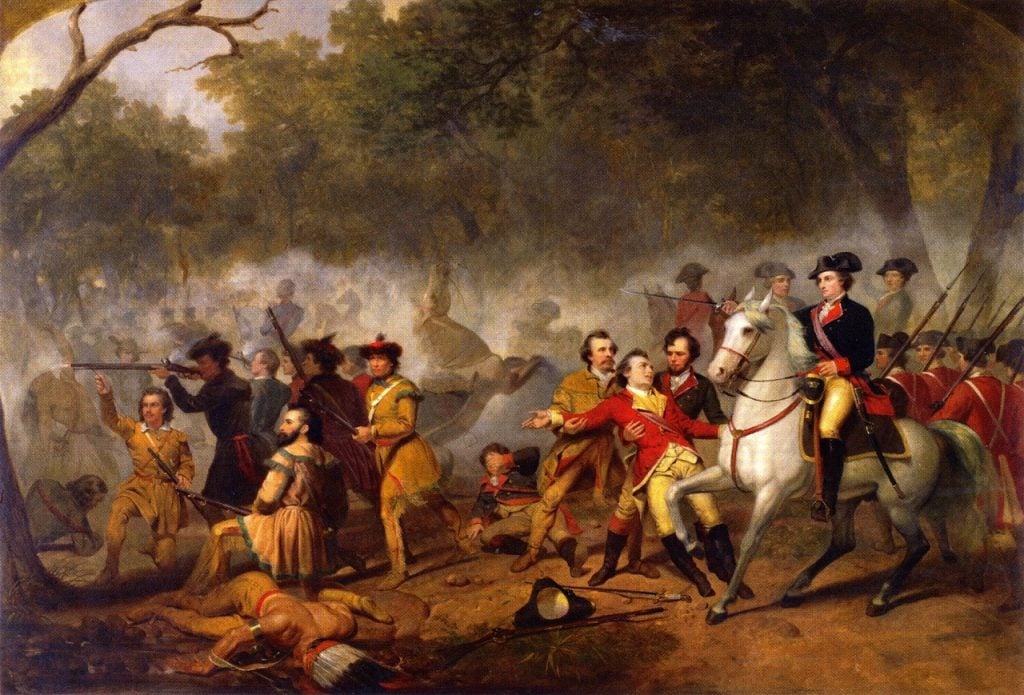“The French and Indian War”

The Seven Years War (1756 to 1763) is sometimes called the First World War because it involved so many different countries and was global in scale. The North American portion of the war is best known in the U.S. as the French and Indian War. In Quebec it is known as La Guerre de la Conquête (The War of Conquest). For the Indian nations, particularly those in the greater Ohio area, some allied themselves with the French, some with the English, and some attempted to stay neutral.
In general, the French had come to North America seeking to exploit its riches through trade. They viewed Indian nations as trading partners and thus they were little concerned with either changing Indian cultures or eradicating the Indians themselves. The French often learned Indian languages and intermarried into the tribes. They ranged far inland seeking trading partners.
The English on the other hand, came to North America seeking land. They viewed the land as a great vacant wilderness in which the Indians were often seen as wild savages. Their policies toward the Indians tended to be genocidal: they wanted the Indians to either die off or to become English. Initially, the English settlers did not range far from the coast, but by the eighteenth century their greed for land brought them farther inland and here they found the French living and trading with the Indians.
While the Seven Years War officially began in 1756, in North America the armed conflicts between the French and the English began in 1754. When the French constructed Fort Duquesne in Ohio in an attempt to gain influence over the Indian tribes in the area, the Seneca leader Tanacharison (Half King) reported this action to the British Virginia forces under George Washington. Tanacharison provided Washington with a delegation of warriors to go with the Virginia forces in an expedition against the French. The combined Virginian and Seneca forces surrounded a French camp, killing 10 and taking 21 prisoners. This was George Washington’s first combat experience.
The wounded French leader attempted to explain that he was on a diplomatic peace mission. Tanacharison, who was more fluent in French than Washington, killed him before Washington understood the nature of his message.
Tanacharison (Half King) then arranged a council between tribal leaders and George Washington. Washington, realizing that he needed the support of the tribes, explained that the purpose of the British military efforts was to maintain Indian rights to the region and to prevent the French from taking their lands. Tribal leaders did not find Washington’s argument to be persuasive. They also knew that the size of the advancing French troops made an alliance with the British a bit risky.
In 1756, England officially declared war on France and then France officially declared war on England. The focus of the war in North America was on the Ohio Valley. The French wanted to consolidate their position in the Ohio which would restrict the English to the area between the Allegheny Mountains and the Atlantic Ocean. On the other hand, the English traders were pushing into the area which had the potential for cutting France’s American empire in two.
The Indian Nations living the Ohio Valley at this time included the Lenni Lenape (Delaware), Shawnee, Wyandot, and Iroquois. In addition, there were a few Abenaki, Nipissing, and Ottawa. In the western portion of the area were the Miami Confederacy and the Illinois Confederacy.
In 1759, the Lenni Lenape under the leadership of Tamaqua made peace with the British. Tamaqua then spread the word of peace to other tribes and the war leaders from the Lenni Lenape (Delaware), Shawnee, Wyandot, Ottawa, Ojibwa, Kaskaskia, Miami, and Potawatomi met at Fort Pitt to make peace by symbolically burying the war hatchet under the tree of peace.
The British demanded that all captives be released as a condition of the peace. From an Indian perspective, this was an unrealistic demand. Many of the captives, mostly women and children, had been adopted into the tribes. Most of the former captives considered themselves to be tribal members. They preferred Indian life to life as British colonists. Indian leaders had no way to force the former captives to return to their old lives, and very few would do so voluntarily.
In 1759, a party of Ottawa, Huron, and Potawatomi encountered an English Ranger group in Michigan. The Ottawa leader Pontiac demanded to know why the Americans were trespassing on Indian land. The Americans told him that they were there only to remove the French. After they gave Pontiac wampum, he smoked with them. While Pontiac agreed to be a subordinate of the English Crown, he told the English that if the King should neglect him, he would shut down all routes to the interior.
In 1760, the war in North America was over: the French forces were defeated and English settlers began to pour across the Alleghenies into the Ohio valley. Indians soon found that they were not welcome at the British forts and intermarriage was discouraged. English actions toward the Indians made it clear that they felt that they had no obligation toward the Native people.
While the French had secured the loyalty of their Indian allies by providing them with ammunition and supplies, the English did not. Lord Jeffrey Amherst wrote:
“I do not see why the Crown should be put to that expense. Services must be rewarded; it has ever been a maxim with me. But as to purchasing the good behavior either of Indians or any others, [that] is what I do not understand. When men of whatsoever race behave ill, they must be punished but not bribed.”
The British placed Jeffrey Amherst in charge of Indian relations in 1761. He took the view that Indians were savages who had to be disciplined to conform to the laws of the British Empire. One of Amherst’s first changes was to eliminate presents given to Indian tribes. He felt that presents encourage laziness and that the Indians should support themselves by hunting so that they could obtain the trade goods which they desired.
The 1763 Treaty of Paris officially ended the French and Indian War (Seven Years’ War). Under the terms of the treaty, which was negotiated with no Indian leaders present, all of the Indian nations east of the Mississippi River were to come under the jurisdiction of the English. Those Indian nations which had allied themselves with the British and helped defeat the French forces were treated the same as those who allied themselves with the French and those who had stayed neutral.



